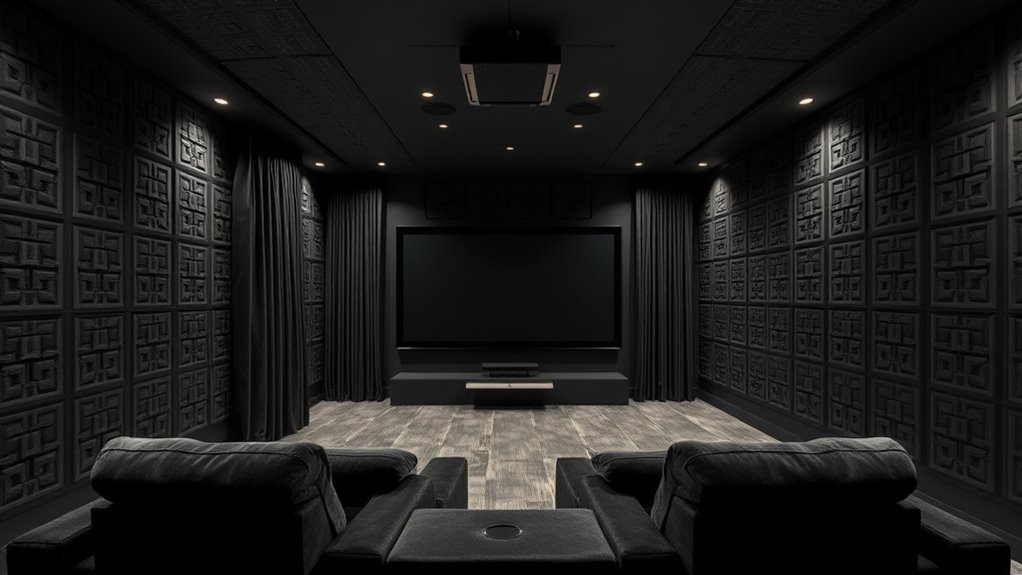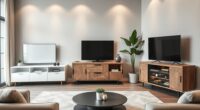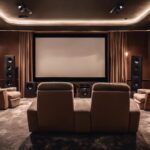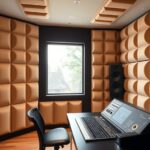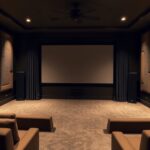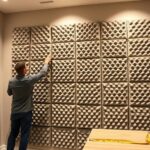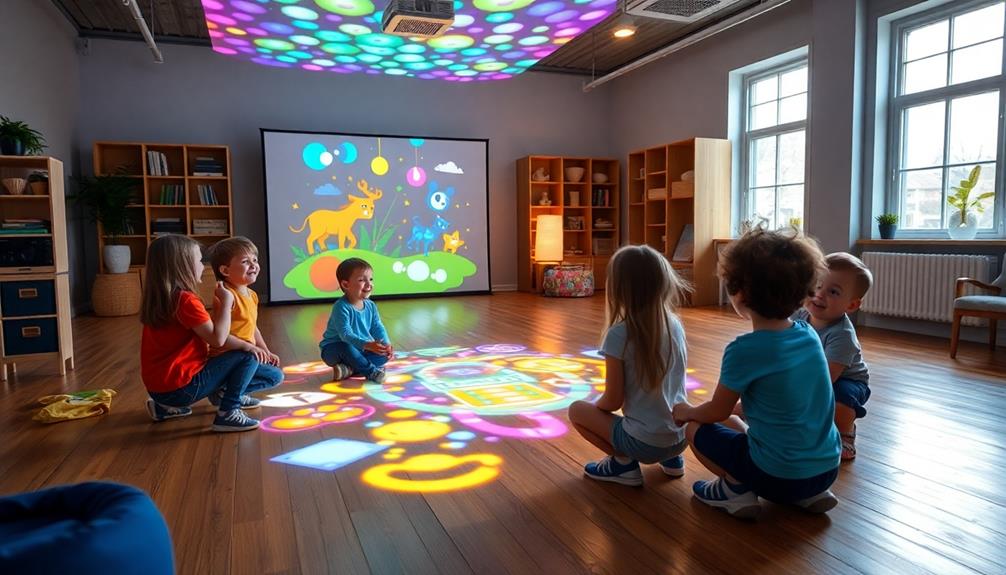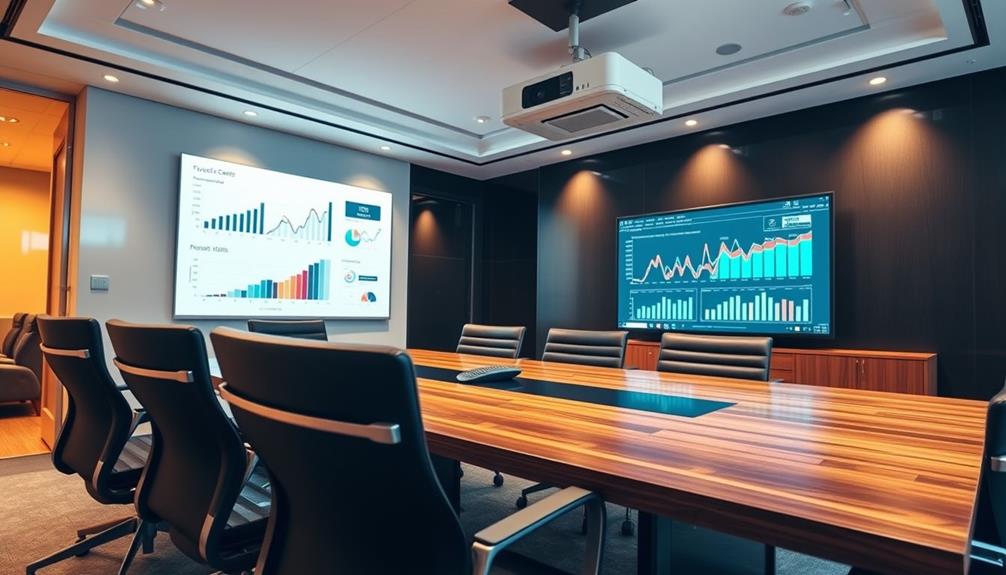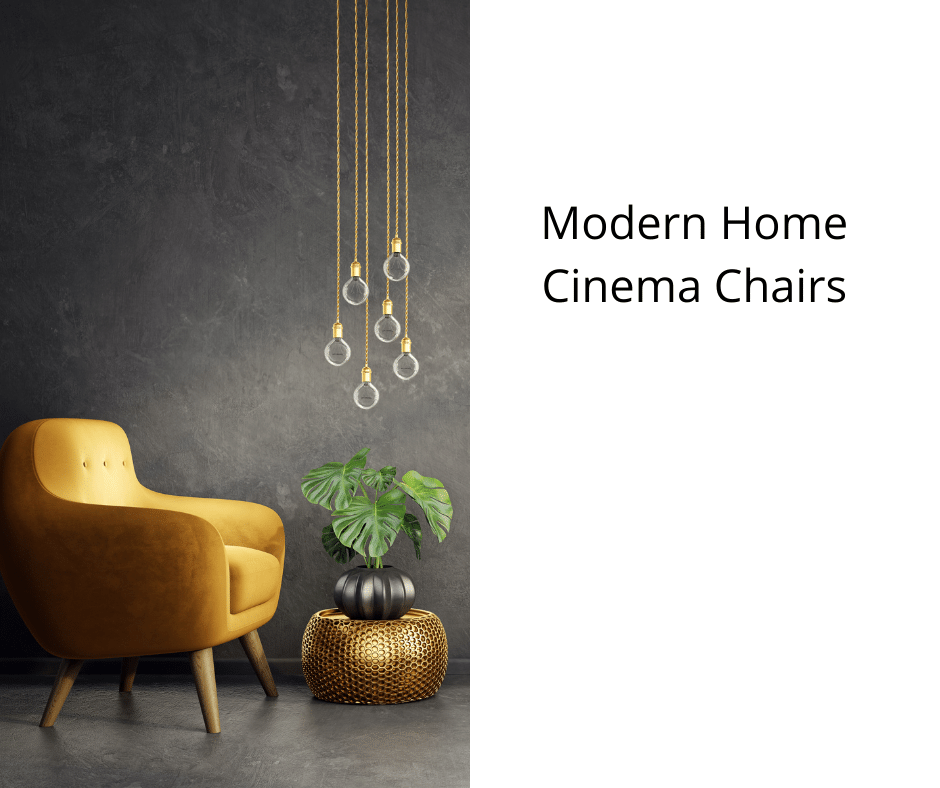To achieve advanced soundproofing in your home cinema, focus on structural modifications like building a room within a room with decoupled walls and using dense, mass-loaded materials like drywall with Green Glue. Seal all gaps and consider installing double-glazed windows and solid-core doors. Add acoustic treatments such as bass traps and sound-absorbing panels to manage reflections. Combining these techniques creates a quieter, more immersive environment—you’ll discover more tips and tricks as you explore further.
Key Takeaways
- Implement a “room within a room” design with decoupled walls and resilient channels to minimize sound transmission.
- Use multiple drywall layers with damping compounds like Green Glue for superior airborne noise reduction.
- Install soundproof doors with solid cores, weatherstripping, and door sweeps to seal gaps effectively.
- Incorporate acoustic treatments such as bass traps, diffusers, and absorption panels to control low frequencies and reflections.
- Seal all gaps, joints, and openings thoroughly and add mass-loaded vinyl (MLV) in ceilings or walls for enhanced sound isolation.
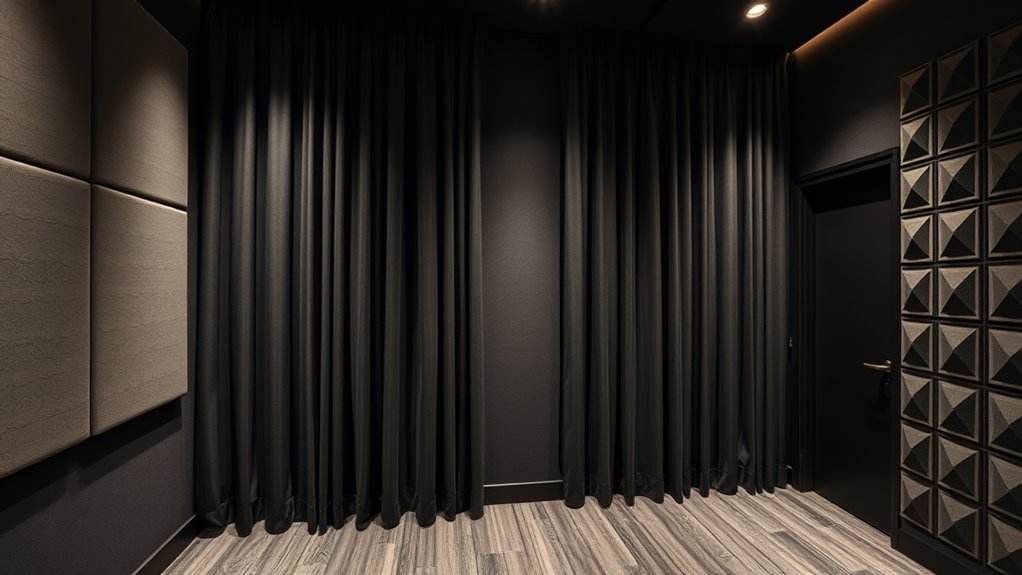
Creating a home cinema that delivers immersive sound without disturbing the rest of your house can be challenging, but effective soundproofing techniques make it achievable. The key is to address both airborne and structural noise, ensuring sound stays within your dedicated space. Start by constructing a room within a room. This involves building a decoupled wall system where the inner wall is separated from the outer wall using resilient channels or isolation clips. This gap prevents vibrations from transferring through the structure, considerably reducing sound transmission. Use dense, mass-loaded materials like drywall or specialized soundproofing panels on these walls. Multiple layers of drywall, combined with damping compounds such as Green Glue, can further improve sound insulation. Green Glue acts as a noise-dampening barrier between layers, converting sound energy into tiny amounts of heat, thereby minimizing sound leakage.
For the ceiling, consider installing a suspended ceiling system with acoustic tiles. These tiles absorb sound waves and prevent them from traveling upward or downward. You can also add a layer of mass-loaded vinyl (MLV) above the ceiling to block sound from escaping through the attic or upper floors. On the floor, use thick carpets or layered rugs with soundproof underlayments to absorb impact noise and prevent sound vibrations from traveling into other rooms below. If your home has a basement or lower level, reinforce the floor with resilient mats or soundproof mats beneath the subfloor. Incorporating soundproofing materials that are specifically designed for impact and airborne noise can further enhance the effectiveness of your setup. Additionally, using structural modifications such as staggered or double-stud walls can significantly improve sound isolation.
Door and window sealing plays an essential role in advanced soundproofing. Replace hollow-core doors with solid-core alternatives, and make sure to install door sweeps and weatherstripping to seal gaps around the edges. For windows, consider installing double-glazed or acoustic windows, or add window plugs when not in use. These steps prevent sound leaks through openings, ensuring your audio experience remains contained. Additionally, soundproofing techniques like adding mass and sealing gaps are crucial for creating a highly effective barrier. Ensuring proper room sealing enhances the overall soundproofing performance and prevents unwanted noise infiltration.
Finally, treat your room with strategic sound absorption and diffusion. Use bass traps in corners to control low-frequency vibrations, and place acoustic panels or diffusers on walls to scatter sound waves evenly. This not only enhances audio clarity but also prevents sound from reflecting and creating echo or muddiness. Incorporating sound absorption materials and techniques further improves overall sound quality and reduces unwanted reverberations. Combining these advanced techniques creates a highly effective barrier, allowing you to enjoy powerful, immersive sound while keeping your home’s peace intact. Properly implemented, your home cinema becomes a private haven where sound quality and tranquility coexist seamlessly.
Frequently Asked Questions
Can Soundproofing Improve Audio Quality Inside the Room?
Improving soundproofing doesn’t just block noise from escaping; it also enhances your inside audio experience. When you reduce external noise and prevent sound reflections, your movie soundtracks sound clearer and more immersive. Proper soundproofing minimizes echoes and unwanted sound interference, letting you enjoy crisp dialogue, deep bass, and detailed effects. So, by investing in effective soundproofing, you’re not only keeping noise in check but also elevating your overall home cinema sound quality.
How Much Does Professional Soundproofing Cost?
When considering professional soundproofing, you’re looking at varying costs based on your project’s scope. Generally, expect to spend between $1,000 and $10,000 or more for a dedicated home cinema. Factors like room size, materials, and complexity influence the price. You’ll get expert installation, ensuring ideal soundproofing and sound quality, but be prepared for a significant investment to achieve top-tier results.
Are There Eco-Friendly Soundproofing Options Available?
You’re wondering if eco-friendly soundproofing options exist. The good news is, they do! You can choose materials like recycled cotton, cellulose insulation, or natural wool, which absorb sound effectively and are sustainable. These eco-friendly options reduce your environmental impact while still providing excellent soundproofing. By selecting such materials, you create a quieter space without compromising your commitment to sustainability, making your home cinema both eco-conscious and acoustically optimized.
How Long Does It Take to Install Soundproofing in a Home Theater?
You wonder how long it takes to install soundproofing in your home theater, as if it’s just a quick fix. Ironically, the process can take anywhere from a few days to several weeks, depending on your room’s size and the methods used. You’ll need time for planning, materials, and installation—so don’t expect instant silence. Patience is key, but the sound of perfection will be worth the wait.
Will Soundproofing Affect Room Ventilation and Airflow?
Soundproofing can affect your room’s ventilation and airflow because it often involves sealing gaps and adding dense materials. This might reduce natural airflow, making your space feel stuffy or uncomfortable if you don’t plan properly. To prevent this, you should incorporate ventilation solutions like vent fans or ducted systems. Proper planning guarantees soundproofing improves your home cinema without sacrificing fresh air or comfort.
Conclusion
By applying these advanced soundproofing techniques, you can transform your home cinema into a fortress of silence, where outside noise is crushed like a mere whisper. With the right insulation, sealing, and acoustic treatments, you’ll experience movie nights so immersive, they’ll feel like you’re inside the action. Don’t settle for ordinary; make your dedicated room a soundproof sanctuary where every sound is crystal clear and every distraction is banished—your perfect home theater awaits!
